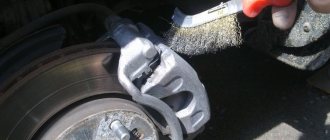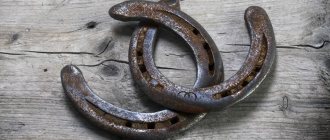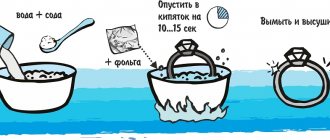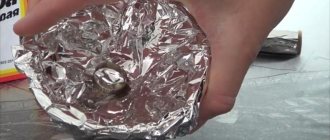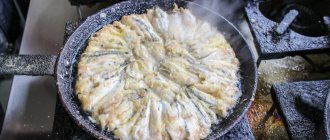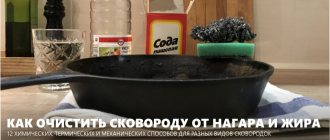Thick-walled cast iron frying pans are valued for their durability and ease of cooking.
However, for a number of reasons, rust may appear on their surface. To remove plaque, use folk methods or special household chemicals.
To protect cast iron from re-oxidation, it is necessary to take preventive measures and properly care for cookware.
We'll tell you how to clean a cast-iron frying pan from rust in this article.
Why does a rusty coating appear?
Why does rust appear on cast iron? Corrosive deposits on the surface of cast iron frying pans can appear for several reasons:
Manufacturing defect. It makes itself felt if low-quality material was used in the manufacture of dishes or the rules for polishing the product were violated.- Illiterate first operation. It consists of ignoring the calcination of the frying pan with oil after purchase.
- Storing food in containers. A wet surface and the presence of food for a long time lead to metal corrosion.
- Rare use of the frying pan for its intended purpose. The less often cast iron is heated, the more chemically active it is.
Advantages of cast iron utensils
Housewives still prefer products made from good old cast iron, which our ancestors used in the distant past. Why? Let's start with the fact that the material has a huge number of advantages. It is famous for its durability and environmental friendliness.
When cooking, for example, fried potatoes, pancakes or pancakes in such a frying pan, you can achieve the golden crispy crust that many people love without burning. Many people prefer to cook grilled dishes in dishes made of this material. Pilaf in a good cast iron cauldron turns out incredibly tasty.
But still, there is one unpleasant disadvantage that you have to constantly fight with. A cast iron frying pan rusts - we will tell you in great detail what to do in this case. It turns out that you shouldn’t give up a good thing, because you can learn how to properly care for it so that such problems no longer arise.
First, let's talk about what leads to the formation of oxidation, as well as the need to treat with various means.
Folk remedies for use at home
At home, you can use different ways to clean cast iron from rusty deposits. Each method has its own level of effectiveness and complexity of application. Common features of folk remedies are low financial costs and accessibility.
Baking soda
The powder is poured onto the bottom of the dish and a small amount of water is added to form a paste . Rub this product into the rusty stains with a soft sponge, and then rinse the container. If traces of rust remain, repeat the soda treatment.
The method is simple, but effective only when corrosion has begun. It is difficult to remove a thick layer of rust using soda.
How to remove table salt?
Regular finely or coarsely ground salt also helps remove rusty deposits.
The product in the amount of 3-5 tablespoons is poured into a bowl and heated over a fire. Next, dilute the salt with water to a thick paste and rub the damaged areas with a sponge .
If the rust cannot be removed the first time, repeat the cleaning with salt or any other suitable means.
Vinegar
To clean, pour a small amount of acetic acid into the dishes and leave to soak for several hours.
The method is one of the most effective , since iron oxide and hydroxide react with acetic acid, as a result of which rust disappears from the surface of the frying pan without heat or physical effort.
However, this method has two limitations. Firstly, for safety reasons you should not use vinegar essence. Secondly, it is undesirable to carry out cleaning without an exhaust hood and with the windows closed.
How to get rid of it with Coca-Cola?
A container larger than a frying pan is filled with Coca-Cola and heated. Lower the frying pan into the dish and leave for 40-60 minutes.
Phosphoric acid contained in the drink reacts and reduces the amount of oxidized iron . Instead of Coca-Cola, you can take any other carbonated drink with similar qualities. The method is considered safe, simple and effective.
Mechanical cleaning
Rust can be scraped off the surface of the pan with steel wool or a stiff brush. The dishes are rubbed until the orange coating completely disappears.
The method is the cheapest, but labor-intensive , as it requires physical effort.
An alternative to a metal sponge can be a sanding machine with a fine sandpaper attachment. The method is effective and appropriate if a thick layer of rust has formed on the dishes, which is difficult to remove with a soft converter.
What to do with a new frying pan to prevent it from rusting
Before you start using a new frying pan, it needs to be properly prepared. Before cooking food in it, the vessel must be heated. First, a clean new frying pan is washed with detergent under running water and wiped dry. Then the kitchen utensils are calcined using any chosen method. After this, you need to leave the pan until it cools and coat it with a cloth with vegetable oil.
You can calcinate in several ways. The procedure is carried out either with vegetable oil or salt. You can pour a little oil into a frying pan, put it on the fire, and wait until it evaporates. There will be a lot of smoke during the process, don't be surprised. The same method can be used with salt. It needs to be poured into a frying pan and put on fire. There will be some burning and hissing in the process. When finished, pour the salt into the trash and wipe the pan with oil.
Frying pan with rust.
Special formulations
Liquids and concentrates designed to remove rust deposits contain potent substances. They provide high efficiency, but require precautions.
When handling products, you should wear rubber gloves and rinse the dishes thoroughly after cleaning.
Sanita Anti-rust
A well-known Russian brand produces a gel-like universal rust remover for metal surfaces. The concentrate contains organic acids, including oxalic acid . They account for up to 30% of all components. The amount of nonionic surfactants is less than 5%.
The gel is applied with a sponge or brush to the rust and left for 3-4 minutes to react. The maximum holding time (with a thick rusty layer) can be 10 minutes. Next, the surface is cleaned with a brush or coarse sponge and thoroughly washed in water. A 500 ml bottle is sold in stores for 85-105 rubles.
Cillit BANG
A universal product made in Russia, designed to remove rust and limescale. The gel formula contains no more than 5% nonionic surfactants. The active substance is oxalic acid.
To clean the surface, it is first moistened with water. Apply Cillit BANG to a sponge and wipe the areas covered with rust. Exposure time depends on the thickness of the plaque and ranges from one to five minutes. After this, the dishes are washed in a large volume of water. The cost of a 450 ml bottle averages 230 rubles.
Syntilor Ruggine
Liquid concentrated rust remover from a Russian manufacturer. The product is intended for cleaning metal surfaces. The composition does not contain chlorine or mercury containing substances. The rust converter is considered safe for human health and the environment and can be discharged into the public sewer system.
Before use, shake the product, dilute it with water in a ratio of 1:3 and apply it with a sponge to rusty spots . Leave the dishes for 5-8 minutes for the reaction to take place. Next, clean the surface with a stiff brush. Complete the procedure by rinsing with water. The average price for a bottle weighing 1 kg is 300 rubles.
Conclusion
A cast iron frying pan is an affordable utensil through the centuries. They came to modern kitchens from grandmothers, but are sold in large quantities in modern markets by different manufacturers. Do not think that if stains appear on it, then it is better not to use it. The rules for caring for a cast iron frying pan are simple, and in return you get delicious products. There are many ways to get rid of rust on a cast iron frying pan; they can be used in any situation.
Previous
Frying pansDouble frying pan: types, device, reviews
Next
Frying pansCustomer reviews about Satoshi frying pans
What should not be used and for what reason?
It is not recommended to use foaming detergents to clean and wash cast iron cookware. They provide a degreasing effect and remove protective oil impregnation. Open pores in cast iron allow moisture to reach the metal and initiate the corrosion process.
Sharp temperature contrasts are taboo. A heated cast-iron frying pan should not be immediately exposed to running cold water. This degrades the quality of the alloy and makes it more brittle.
Do not use metal brushes unless absolutely necessary . They damage the protective coating and make the cast iron surface vulnerable to moisture and chemicals.
Why does a cast iron frying pan rust and how can you protect yourself from it?
Many people wonder why their new cast iron cookware began to rust or why red spots suddenly appeared? Why does the cast iron of our grandparents not rust, even under extreme conditions, but the newly purchased product rusts after the first use (or after some time). Let's try to figure it out.
First of all, it is important to understand that cast iron is an alloy of iron and carbon, which has a carbon content of at least 2.14%. Unlike stainless steel, which is an alloy of iron and chromium with a content of at least 13%, it is carbon that gives the alloy its hardness, and that is why cast iron becomes a hard and brittle alloy. At the same time, cast iron, unlike stainless steel, does not have components that would protect the iron from corrosion. Therefore, cast iron, like iron, can rust.
How to restore the protective layer?
After any cleaning, rinse the pan with plenty of water and wipe dry with a towel or napkin. After this, they begin to create a protective layer that protects the cast iron from corrosion.
The work includes several steps:
heat the oven to 180 degrees;- grease the frying pan with a thin layer of vegetable oil;
- place the dishes in the oven upside down;
- heat the pan for an hour;
- keep the dishes in the oven until completely cool;
- Rinse the pan with warm water and wipe dry.
To coat the frying pan, you can use any type of vegetable oil, except olive oil (it smokes when fired), as well as any type of animal fat.
Oil and melted fat penetrate into the micropores of cast iron, creating a waterproof coating. This method of protection must be used after each cleaning of dishes, regardless of the product used.
General information
Causes of rust formation
Despite its high strength characteristics, cast iron can also rust, because this material can be classified as a ferrous metal, which means it is highly susceptible to corrosion. Rust can be called a product of metal oxidation, which appears due to the reaction of metal with oxygen with the participation of water or some aggressive chemicals. Only simple carbon steel will rust easily, and all other metals are less likely to suffer from the effects of corrosion. If rust stains are found on the surface of the cast iron,
then the following may be the reason:
- Low quality characteristics of the material. To reduce costs, unscrupulous manufacturers do not make dishes from pure cast iron, but add various inexpensive additives.
- Violation of the rules for caring for dishes. If after washing you leave the dishes wet so that they dry naturally, or constantly store the item in a room where there is a high level of humidity + no heating, then rust will appear very quickly. A similar problem occurs when regularly washing a frying pan with cold water immediately after cooking is finished.
- Rare use of utensils. Cast iron frying pans or other items made of this ferrous metal must be used regularly, otherwise the coating begins to deteriorate even without human intervention.
- There is no oil film on the surface. Fat and oil help to reliably protect products from rusting, and therefore dishes should be regularly treated with just such substances. For a similar reason, new utensils should be treated with vegetable oil before initial use.
Now let's talk about preparing the dishes for use.
Preparation for use
In order for the new product to serve the housewife for as long as possible, after purchase, special attention should be paid to preparing the dishes for cooking. To begin with, the frying pan/cauldron/saucepan should be washed with laundry soap or other dishwashing detergent. Afterwards, wipe the cast iron with a soft towel, place it on the stove, pour in a little vegetable oil. You should heat the dishes and distribute the oil evenly over the entire surface. It is this procedure that helps close the pores in new dishes, and will also be excellent for preventing corrosion.
Please note that products that do not have plastic handles will be much more convenient to bake in the oven by pouring in oil and leaving to heat until light smoke starts to appear. You can heat an empty frying pan in the oven, and then immediately coat it with vegetable oil using a silicone culinary brush.
Corrosion prevention and care recommendations
To ensure that a cast iron frying pan does not cause problems, it is necessary to adhere to the following care rules during its entire service life:
- Cast iron cookware is not intended for storing food, as a humid environment provokes corrosive processes. Food is removed from the pan immediately after cooking.
- After cooking, a frying pan that has not yet cooled down should not be placed under cold water immediately; it needs time to cool naturally.
- It is recommended to maintain the oily impregnation throughout the entire service life. If the protective layer has disappeared, it must be restored.
- It is advisable not to fry or simmer foods with an acidic reaction (tomatoes, pickles, citrus fruits, sauerkraut) in cast iron dishes.
- If the food is burnt, then fill the frying pan with water, heat it over the fire and give it time to soak. This will allow you to do without harsh washcloths and soap, which remove the protective layer.
Adviсe
When cleaning, it is recommended to give preference to more gentle methods and means . The most aggressive methods include mechanical grinding, so it should be used only as a last resort.
After restoring the protective coating, cleaning gels should not be used. They remove the oily layer.
Rinse the pan under running hot water, using a soft sponge at the same time. After removing the rust, the container should be thoroughly dried with a towel or by heating over a fire.




